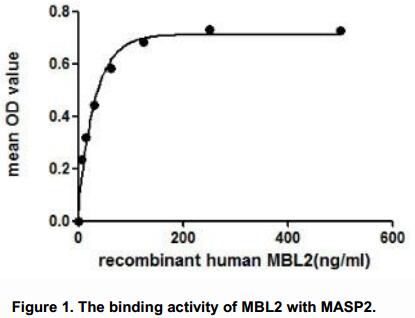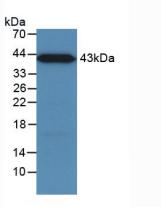Active Mannose Binding Lectin (MBL) 

MBL2; COLEC1; HSMBPC; MBP1; MBP; Collectin-1; Mannose-binding protein C; Mannan Binding Protein; Mannose-Binding Lectin(Protein C)2,Soluble(Opsonic Defect)
Overview
Properties
- Product No.APB480Hu02
- Organism SpeciesHomo sapiens (Human) Same name, Different species.
- ApplicationsCell culture; Activity Assays.
Research use only - DownloadInstruction Manual
- CategorySignal transductionInfection immunityImmune molecule
- Buffer Formulation20mM Tris, 150mM NaCl, pH8.0, containing 1mM EDTA, 1mM DTT, 0.01% SKL, 5% Trehalose and Proclin300.
- Traits Freeze-dried powder, Purity > 97%
- Isoelectric Point5.8
Sign into your account
Share a new citation as an author
Upload your experimental result
Review

Contact us
Please fill in the blank.
Activity test

MBL2 (Mannose-binding protein C) is a calcium-dependent lectin involved in innate immune defense, which binds mannose, fucose and N-acetylglucosamine on different microorganisms, therefore results in activation of the lectin pathway of the complement system. It has been proven that MASP-2 (Mannan-binding lectin serine protease 2) forms complexes with the pattern recognition molecules MBL2, triggers the activation of the complement system. Thus, a functional binding ELISA assay was constructed to detect the association of rhMBL2 with MASP2. Briefly, rhMBL2 were diluted serially in 10mM Tris-HCl, 1M NaCl, 5mM CaCl2, and 0.05%Triton X-100 (pH 7.4). Duplicate samples of 100uL were then transferred to MASP2-coated microtiter wells and incubated for 2h at 37oC. Wells were washed with PBST and incubated for 1h with anti-MBL2 mAb, then aspirated and washed 3 times. After incubation with HRP labeled secondary antibody, wells were aspirated and washed 3 times. With the addition of substrate solution , wells were incubated for 15-25 minutes at 37oC. Finally, add 50µL stop solution to the wells and read at 450nm immediately.
The binding activity of MBL2 with MASP2 was shown in Figure 1 and this effect was in a dose dependent manner.
Usage
Reconstitute in 20mM Tris, 150mM NaCl (pH8.0) to a concentration of 0.1-1.0 mg/mL. Do not vortex.
Storage
Avoid repeated freeze/thaw cycles. Store at 2-8°C for one month. Aliquot and store at -80°C for 12 months.
Stability
The thermal stability is described by the loss rate. The loss rate was determined by accelerated thermal degradation test, that is, incubate the protein at 37°C for 48h, and no obvious degradation and precipitation were observed. The loss rate is less than 5% within the expiration date under appropriate storage condition.
Increment services
-
 BCA Protein Quantification Kit
BCA Protein Quantification Kit
-
 Molecular Mass Marker for Protein
Molecular Mass Marker for Protein
-
 Monoclonal Antibody Customized Service
Monoclonal Antibody Customized Service
-
 Polyclonal Antibody Customized Service
Polyclonal Antibody Customized Service
-
 Protein Activity Test Experiment Service
Protein Activity Test Experiment Service
-
 Electrophoretic Mobility Shift Assay (EMSA) Experiment Service
Electrophoretic Mobility Shift Assay (EMSA) Experiment Service
-
 Buffer
Buffer
-
 Lentivirus Packaging Experiment Service
Lentivirus Packaging Experiment Service
-
 Adenovirus Packaging Experiment Service
Adenovirus Packaging Experiment Service
-
 Real Time PCR Experimental Service
Real Time PCR Experimental Service
-
 Spike RBD Protein (S-RBD)
Spike RBD Protein (S-RBD)
-
 Protein G
Protein G
-
 Protein A
Protein A
Citations
- Analysis of the Urine Proteome of Human Contrast-Induced Kidney Injury Using Two-Dimensional Fluorescence Differential Gel Electrophoresis/Matrix-Assisted Laser Desorption Time-of-Flight Mass Spectrometry/Liquid Chromatography Mass Spectrometry. Karger: 000255439
- Serum Levels and H/L Gene Polymorphism of Mannose-Binding Lectin in Primary Open Angle GlaucomaIngenta: art00007
- Complement activation contributes to the injury and outcome of kidney in human anti-glomerular basement membrane disease.PubMed: 22941511
- Urinary mannose-binding lectin is a biomarker for predicting the progression of immunoglobulin (Ig)A nephropathyPubMed: PMC3406374
- Alternative Complement Pathway Activation Products in Urine and Kidneys of Patients with ANCA-Associated GNPubmed: 24115193
- Novel findings on the role of ficolins and colectins in the innate response against Leishmania braziliensisPubmed: 32827456
- Complement activation profile of patients with primary focal segmental glomerulosclerosisPubmed: 32569286
- The lectin pathway of complement and the initial recognition of Leishmania infantum promastigotes34242658









